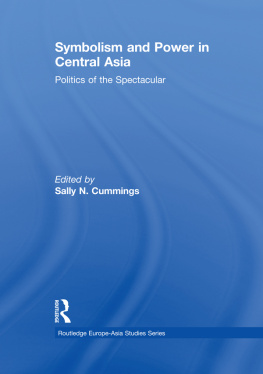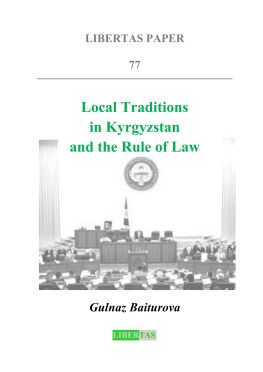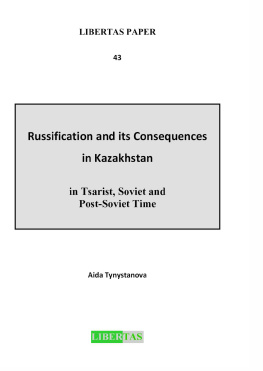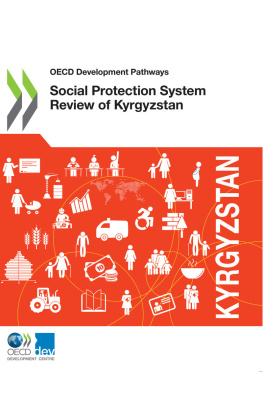Domestic and International Perspectives on Kyrgyzstans Tulip Revolution
In early 2005 regional protests in Kyrgyzstan soon became national ones as protesters seized control of the countrys capital, Bishkek. The countrys president for fifteen years, Askar Akaev, fled the country and after extensive looting, a new acting president, Kurmanbek Bakiev, came to power. The events quickly earned the epithet Tulip Revolution and were interpreted as the third of the colour revolutions in the post-Soviet space, following Ukraine and Georgia.
But did the events in Kyrgyzstan amount to a revolution? How much change followed and with what academic and policy implications? This innovative, unique study of these events brings together a new generation of Kyrgyz scholars together with established international observers to assess what happened in Kyrgyzstan and after, and the wider implications.
This book was published as a special issue of Central Asian Survey.
Dr. Sally N. Cummings teaches in the School of International Relations at the University of St. Andrews, UK. Her publications include: Kazakhstan: Power and the Elite (IB Tauris 2005), Oil, Transition and Security in Central Asia (London and New York: Routledge, 2003) and Kazakhstan: Centre-Periphery Relations (London: Royal Institute of International Affairs and Washington, DC: Brookings Institution, 2000).
Thirdworlds
Edited by Shahid Qadir, University of London
THIRDWORLDS will focus on the political economy, development and cultures of those parts of the world that have experienced the most political, social, and economic upheaval, and which have faced the greatest challenges of the postcolonial world under globalisation: poverty, displacement and diaspora, environmental degradation, human and civil rights abuses, war, hunger, and disease.
THIRDWORLDS serves as a signifier of oppositional emerging economies and cultures ranging from Africa, Asia, Latin America, Middle East, and even those Souths within a larger perceived North, such as the U.S. South and Mediterranean Europe. The study of these otherwise disparate and discontinuous areas, known collectively as the Global South, demonstrates that as globalisation pervades the planet, the south, as a synonym for subalterity, also transcends geographical and ideological frontiers.
Terrorism and the Politics of Naming
Edited by Michael Bhatia
Reconstructing Post-Saddam Iraq
Edited by Sultan Barakat
From Nation-Building to State-Building
Edited by Mark T. Berger
Connecting Cultures
Edited by Emma Bainbridge
The Politics of Rights
Dilemmas for feminist praxis
Edited by Andrea Cornwall and Maxine Molyneux
The Long War Insurgency, Counterinsurgency and Collapsing States
Edited by Mark T. Berger and Douglas A. Borer
Market-led Agrarian Reform
Edited by Saturnino M. Borras, Jr.
After the Third World?
Edited by Mark T. Berger
Developmental and Cultural Nationalisms
Edited by Radhika Desai
Globalisation and Migration
New issues, new politics
Edited by Ronaldo Munck
Domestic and International Perspectives on Kyrgyzstans Tulip Revolution
Motives, mobilization and meanings
Edited by Sally N. Cummings
Domestic and International Perspectives on Kyrgyzstans Tulip Revolution
Motives, mobilization and meanings
Edited by Sally N. Cummings
First published 2010 by Routledge
2 Park Square, Milton Park, Abingdon, Oxon, OX14 4RN
Simultaneously published in the USA and Canada
by Routledge
711 Third Avenue, New York, NY 10017
Routledge is an imprint of the Taylor & Francis Group, an informa business
2010 Central Asian Survey
All rights reserved. No part of this book may be reprinted or reproduced or utilised in any form or by any electronic, mechanical, or other means, now known or hereafter invented, including photocopying and recording, or in any information storage or retrieval system, without permission in writing from the publishers.
British Library Cataloguing in Publication Data
A catalogue record for this book is available from the British Library
ISBN10: 0-415-49190-8
ISBN13: 978-0-415-49190-7
Contents
Sally N. Cummings
Erica Marat
Sally N. Cummings and Maxim Ryabkov
Shairbek Juraev
David Lewis
Alexander Kupatadze
Maxim Ryabkov
Azamat Temirkulov
Emir Kulov
Bermet Tursunkulova
Stefanie Ortmann
March and after: what has changed? What has stayed the same?
Erica Marat
This contribution recalls the major events that have taken place since 24 March 2005. It examines Bakievs new government formed in December 2007, analyses the changes in criminal world dynamics, explains problems in the hydro-energy sector, and concludes with a section on civil society groups. The piece demonstrates how corruption, crime and politics are interlinked in the country and how, on the other hand, local civil society groups have proved to be considerably more stable compared to political parties.
Situating the Tulip Revolution
Sally N. Cummings and Maxim Ryabkov
The authors assess various writings on the coloured revolutions more generally and the Tulip Revolution specifically. They place this scholarship into three broad categories: an assessment of the Akaev years from a democratization and state-building perspective; the nature of and relationship between formal and informal institutions prior to and after March 2005; and, finally, the domestic and international factors behind mobilization. These correspond broadly to the three areas of enquiry by the contributors to this collection.
Kyrgyz democracy? The Tulip Revolution and beyond
Shairbek Juraev
This contribution suggests that commentators have over-emphasized a democratic meaning behind the Tulip Revolution, partly because of a certain misrepresentation of transition in post-1990 Kyrgyzstan. The notion of political competition has been particularly important, a consistent feature of Kyrgyz politics that has suggested a liberalizing tendency in Kyrgyzstan. The nature of contestation, however, is at least partially linked to the traditional societal organization of the Kyrgyz ethnic group, and particularly to its multilayered division into sub-ethnic groups that are in a state of stable competitive relationship to each other.
The dynamics of regime change: domestic and international factors in the Tulip Revolution
David Lewis
This contribution argues that analysis of the overthrow of President Askar Akaev in Kyrgyzstan in 2005 has tended to overemphasize external factors in the revolution, while underplaying local dynamics, which were complex, difficult to understand, and did not fit with a much simpler narrative of democratic change, inspired by external encouragement. In reality, popular discontent, mobilized by local elites in their support during a highly competitive electoral process, led to elite defection and cross-regional political alliances that severely undermined the Akaev regime. International engagement, and Westernfunded NGOs and civil society groups played a much more marginal role than is normally portrayed. For the most part, Western groups engaged with an almost virtual sphere of politics, in which NGOs and democracy groups predominated, but where there was little ability to influence the real world of the Kyrgyz polity. The narrative that exaggerated external factors and the role of civil society has been used by neighbouring authoritarian leaders, in their own interests. It also raised expectations of political change in Kyrgyzstan that were unlikely to be fulfilled.















